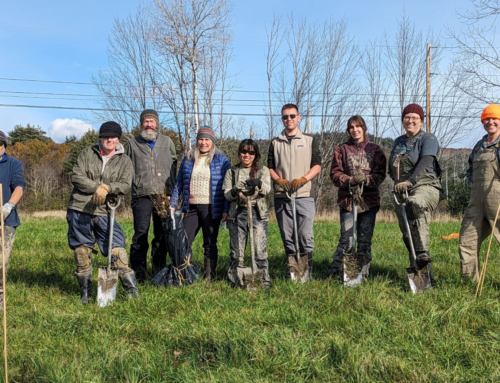October 23, 2013
Shauna Little
U.S. EPA – Region 1
5 Post Office Square, Suite 100 (OEP-06-1)
Boston MA 02109-3912
Subject: Chang Farms draft NPDES Permit, Whately MA
Permit Number: MA0040207, Public notice MA-025-13
Dear Ms. Little,
I am submitting comments on the draft National Pollutant Discharge Elimination System (NPDES) permit for Chang Farms in Whately on behalf the Connecticut River Watershed Council (CRC). The discharge point into the Connecticut River is just downstream of the Sunderland Bridge, which has a boat launch and fishing access point maintained by the Town of Sunderland. The section of the Connecticut River in the area of the discharge is a popular area for canoeing, kayaking, and motor boating when river depths allow. Swimming takes place off private land along the river in the vicinity of the discharge. This section of the river is also probably the most commonly photographed stretch of river – Mount Sugarloaf State Reservation located in Deerfield on the north side of the Sunderland Bridge affords one of the most spectacular views of the Connecticut River and its valley.
The Connecticut River upstream of the Holyoke Dam is listed as an impaired water body due to priority organics and pathogens. We are particularly interested in improving water quality in the Connecticut River such that it can one day meet Class B water quality standards and be safe for swimming. Our comments are below.
- We note that the facility has expanded its water withdrawals and is requesting an increase in discharge flow. CRC visited the site during the Masachusetts Environmental Policy Act (MEPA) review process in 2005, and commented then and again during 2011 when it went through MEPA for expanded water withdrawals. CRC submitted comments to Massachusetts Department of Environmental Protection (MassDEP) on the Water Management Act permit in 2011, and to EPA on the 2006 NPDES permit. In 2005 and 2006, future expansion plans were openly discussed.
- CRC supports the addition of a maximum daily flow rate, so that the water flowing through the facility does not overtax the capacity of the ultraviolet treatment process. We note that there have been high levels of E. coli bacteria in detected in October 2010, April 2012, and May 2012. We aren’t sure what led to these high levels and whether the expansion poses a problem for keeping those levels low.
- CRC supports the addition of a temperature limit in the draft permit.
- The existing and draft permit requires weekly testing of total residual chlorine (TRC). The Fact Sheet on page 15 states that the most recent TRC testing was completed in March 2011. A search on the EPA ECHO database for Chang Farms yields zero TRC data for outfall 001. Has TRC not been monitored weekly as the 2006 requires? If not, why? As noted in the Fact Sheet, chlorine and chlorine compounds can be extremely toxic to aquatic life, and chlorine is added to groundwater from the well fields to wash and soak the beans. It is important to have a sense of the chlorine amounts in the effluent, particularly because the facility is looking to expand its discharge more than four-fold.
- CRC supports the increased measuring frequency of total suspended solids (TSS) and BOD5. Based on our understanding of the bean sprout production process at the facility and description and list of chemicals in the Fact Sheet, it is unclear why the facility has had such frequent violations of their TSS and BOD limits over the past 5 years. Though we are glad the concentration limits from the 2006 permit are being maintained, we are disappointed that the loading values will be allowed to increase to such a degree, particularly when this expansion was anticipated back in 2005.
- CRC supports the increased frequency of nutrient monitoring and capping the loading of total nitrogen to 12.4 lbs/day.
- Footnote 3 on page 4 of the permit should probably say “aliquots” rather than “aloquits.”
- With regard to the federally endangered shortnose sturgeon (SNS), Holyoke Gas & Electric was required by NOAA for several years to conduct radio tracking studies of 20 tagged SNS upstream of the dam each year, to record their movements and see if any moved downstream and approached the Holyoke dam. This document is available in full on the FERC e-library (docket P-2004), but relevant excerpts are attached here. Of the tagged SNS individuals, two of them were recorded in the vicinity of Chang Farms. We disagree with EPA that SNS are unlikely to be in the area and we believe consultation with the National Marine Fisheries Service is warranted.
- According to Attachment 3 to the Fact Sheet, the Discharge Monitoring Data, this facility has a record of at least one permit violation in every month between 2009 and the beginning of 2013, except for possibly two months. That is quite a poor record. We hope that EPA and MassDEP enforce the permit limits on the new permit.
Thank you for an opportunity to comment on this draft permit for Chang Farms.
Sincerely,
Andrea F. Donlon
River Steward
ATTACHMENTS: HG&E Shortnose Sturgeon report excerpts
cc: Kathleen Keohane, MassDEP
Chris Duerring, MassDEP
Cindy Delpapa, Massachusetts Division of Ecological Restoration







